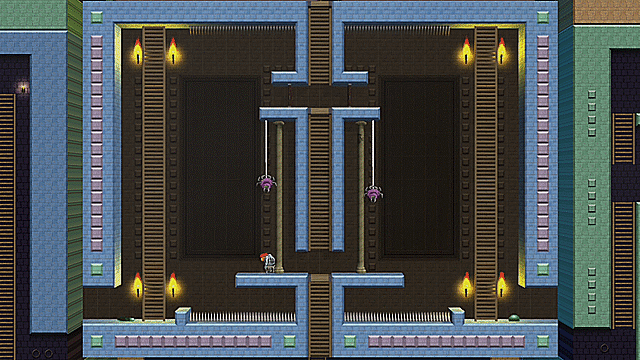David Ferriz, Director and Game Designer of the team, explains how we approached King Lucas to get that retro feeling.
 In the previous post of King Lucas devblog I explained how the former idea was born but I didn’t tell you how it became what it is today. In this new post I’m going to try to give you some details about the game design process.
In the previous post of King Lucas devblog I explained how the former idea was born but I didn’t tell you how it became what it is today. In this new post I’m going to try to give you some details about the game design process.
The influences
Me and my associate spent our childhood playing 8 bit games. Enrique had a 286 where he used to play Goody, Fury of the Furries and Prince of Persia (the real one, that still hadn’t got “bullet time” and those kind of things). In my case, my first contact with games was the Master System II and my favourite ones were platformers. I remember wasting hours and hours playing Alex Kidd in Miracle World, Castle of Illusion, Asterix, The New Zealand Story, Alien 3 or Sonic as well as I had really good times playing games of some other genres such as Shadow of the Beast or Gaunlet and in other consoles like Super Mario World 3 in NES.

The former idea
Enrique and me agreed we wanted to make a platformer like “those from the good old times”. This means we wanted something direct and simple for the user, something that wouldn’t need a 10 minutes tutorial to start playing and no more buttons than the Master System II or NES controllers had.
The classics that inspired us offered a short game experience (from 2 up to 3 hours) and, although we wanted to deliver that 8 bit experience, we didn’t want to limit ourselves to carbon copy those games and miss the possibilities of the actual technology, so we decided to create an experience long enough to fulfill the expectations of nowadays players, because launching a 3 hours game and succeed is something that only some privileged get, like Limbo. In order to reach this goal we designed a single player mode that offers between 6 and 12 playing game as well as a online multi-player mode that extends the product life.

A changing castle
In Alex Kidd, Castle of Illusion or Prince of Persia the goal was to rescue somebody, usually a princess. We decided to keep that schema, but with a non-linear game narrative in which the player can choose hundreds of different routes to get to the end (that’s why the playing time of King Lucas has such a wide range).
Some roguelike or metroidvania games generate levels and mazes in a completely procedural way, but we didn’t want to leave the level design in the hands of an algorithm. We’ve always thought that each tile, each jump, each secret passage and each danger must be strategically located so we chose to hand design hundreds of different rooms to then combine them so together they build a different massive castle for each quest and for each player.

The game design document
If your reading this devlog you may probably already know that a design document is the bible where all the details of the game to be developed are compiled in order to be a reference for the whole team through the process. To make this document is usually a laborious job but it really save a lot of time in the development.
Starting from the point of creating a platformer with classical mechanics set in a large castle that changes in each play, in early 2013 we began to write the game design document without having very clear which platform the game was going to be oriented for. We had a lot of experience developing Flash and mobile games so initially started to make prototypes for mobile devices, web browsers and Facebook with a free 2 play model in mind, like Candy Crush, but as soon as we showed the game in some events and see the reaction of the users we realized that we hadn’t a mobile game; it deserved to be played with a controller or a keyboard!
Moreover, I’ve never been a free 2 play advocate because I think that if you fail in tuning the model you may end up screwing a good game and even getting very low profitability. While writing the design document I was worried about using too much time thinking of monetization instead of dedicating these efforts to think about how to make the users have fun so, even though discarding the work done up to that date was a hard decision, finally we forgot the tactile control, the free 2 play model and we focused on working to launch King Lucas for PC, Mac and Linux in Steam (and maybe consoles later).
As you probably guess, dismiss the design with half development advanced is not the ideal way of working and it delayed our launch but it’s also true that, now when the game is almost finished, I think it was the best of the choices because if we had been limited by these factors we wouldn’t have been able to make the game that we really wanted to.
The gameplay
After showing the trailer and the beta version of the game in several festivals we received a very valuable feedback and that helped us much to improve the game but we are also aware that, even with those improvements, maybe some players won’t find in it what they look for in a game. From the very beginning a lot of users have compared King Lucas to Rogue Legacy and other action games; of course that’s a compliment for us but that has never been our goal. In King Lucas you can fight a good bunch of enemies, final bosses and use a lot of weapons and shields, but fights are not the main part of the game and, being honest, there’s no frenetic action here nor hundreds of enemies and heavy shooting on screen.
In fact King Lucas is a platformer where the important thing is to get yourself oriented in its massive castles and for it we created two significant items: the compass (that points to your goal) and the crystal ball (that tells you how many rooms there are between you and it). These items, together with the keys to open doors, are the key advantages in order to not wander aimlessly through the castle and overcome the quests, independently of the power and endurance of your chosen weapons (that also help, but not so much).
To complete the inventory we included the classical health and invincibility potions that no classical platformer should lack.

The outcome
After almost 4 years of development, some weeks ago we could make the first formal round of beta testing which gave us useful insights in order to balance the difficult of the game as well as the prices of weapons and other items. Right after playing for 30 hours that beta on myself I suddenly felt a huge need of revisiting the classics that inspired us and that, in some cases, I hadn’t played for more than 20 years. It was after some plays with my old Master System when I understood how much weight those games had carried and how, almost in an unconscious way, we had recreated so many references and homages to them inside King Lucas.
Some days ago my father -who’s always concerned about my company but know nothing about games- asked whether King Lucas was “the kind of game that sells today“. Honestly, this question puzzled me and I did my best not to reply because the answer wouldn’t have probably reassured him. On one hand, the honest answer would have been no, King Lucas is not the game somebody would create actually in order to make money but, on the other hand, I’m sure that if we reach the players who grew up playing Alex Kidd, Wonder Boy or Castle of Illusion and we achieve to transport them to their childhood for a few hours at least we will have a chance to cover the investment made in these 4 years of development.
Remember that you can sign up to the distribution list of King Lucas in order to be notified as soon as the launch discount is available at www.kinglucas.com!

